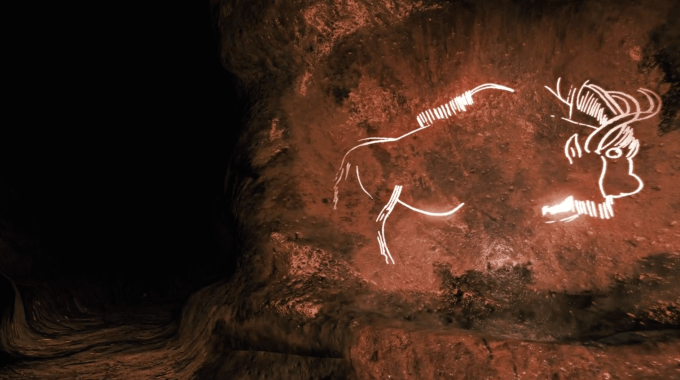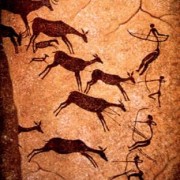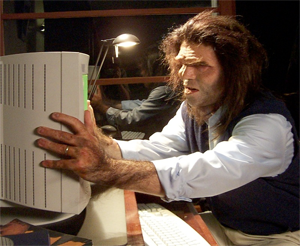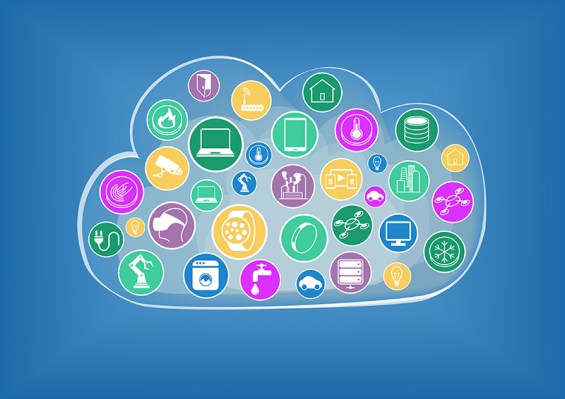Before the iPhone, we lived in caves.
And it was easy to organize things in our cave. Rocks went in the rock pile. Clubs went in the club pile. Bones went in the bone pile. We sorted, organized, and classified to manage our things.
As more people came to live in our cave, managing things got a little more complicated. Ringo brought multiple rocks. One was for banging, one was for fishing, and one was for sleeping.
Suddenly, a single rock pile was not enough to organize our rocks. When it was time to go fishing, @Ringo only needed his #rock that was used for #fishing.
When we began cultivating human language—so we could talk about how we use our rocks for fishing and sleeping, for example—our organizational challenges were met head on. We developed structures in our communications to identify our things (a.k.a. nouns), descriptors of our things (a.k.a. adjectives), what we do with or to our things (a.k.a. verbs), and even descriptors for how we do what we do with or to our things (a.k.a. adverbs).
We happily moved forward as a species through the years using language, in all its many variations, to describe our interactions with the world around us. There was wide diversity in the sounds, symbols, words, intonations, and dialect used to communicate, but the basic structure remained. Our brains worked well with this form, and we told amazing stories about people, places, and of course things.

Explore The Cave
Our stories inspired us to create and build, and we eventually invented things that can also tell stories.
But our new creations were less capable than our brains, so we developed a much more basic language to allow them to speak. This language was not centered on organization, nor was it about storytelling. It was really just for messages. Its “stories” were short and concise, carrying the minimum information required to convey the simple message of a thing.
This language became the standard for technology, and technologists used this message-based way of thinking in many of their designs and interactions. Even when it came to the matter of how other actual people use the things, technologists did little to elevate the language to “people speak.”
For the most part, this is where we are today.
Our caves have been upgraded, and our things are now in rooms. In many thing-management schemes, rooms are the full extent of our organization—they are our only piles. But we can do better.
Sure, the amount of things per person has increased greatly, but the principle of organization hasn’t changed much. For example, thanks to the good people at Facebook, one of the “things” we now have most is “friends.” While it is ill-advised to put friends in piles, we can and dotag them in photos and put them in groups to keep track of their relevance to us.
Now, as the Internet of Things (IoT) becomes part of our lives, more and more of our “things” are learning to talk. As with our friends, some things are more chatty than others and the importance of the stories they tell varies greatly depending on the thing in question.

So, in addition to sorting and grouping and organizing the actual things, we also find ourselves needing to sort and group the tales that our things tell. Sound complicated?
As it is with sorting our friends and neighbors, sorting stories is also nothing new. Newspapers (they came after the cave, but before the iPhone) sorted stories all the time. They sorted them by category, by time, by importance, by author, by season, and by whatever the layout and editorial staff felt were good organizational sorting choices. Of course, as news moved into the ether, the sorting and organizational options increased dramatically. Tag clouds became a thing to show how people think, search, and ultimately feel about all of these associated groups of information.
Now with our things, and their stories, we can leverage Thing Association Groups (or TAGs—because you can never have enough of abbreviations in your pile of acronyms) to reduce the aforementioned language barrier between people and technology. Where to start, you ask?
Consider, for the sake of conversation, that the things in your life are like employees. They are hired by you to do a job. Imagine how you might organize your own company to manage these employees, their assignments, their responsibilities, their productivity, etc. TAGs can be helpful in doing this. For example, if you hire three light bulbs—regardless of their origin, language of choice, or lineage—there are key TAGs you might employ to make them relevant.
One notable one is, of course, “light.” You might also include where each light bulb is located, like “bedroom.” If one light can change colors, you might add the TAG, “color.” If it belongs to me, I might add the TAG, “Jim.” If I use it for reading, I might use the tag “reading.” If I particularly like it, I might tag it “fun.” You get the idea.
An important note here: A TAG is not to be confused with hierarchal organization structures, such as the traditional file+folder systems on computers. Despite the TAG acronym, a group is not actually created or maintained. TAGs are simply any number of keywords associated with any number of things that results in naturally grouped query results.
For example, take the query: “Show me all my things that have the TAG ‘party.’”
This should obviously return a list of things that have the TAG “party.” Actually, there are potentially two tags in this example, since the word “my” can be an inferred tag if there is an implementation of ownership in use and the requester can be identified. These keywords can be added and removed extremely easily by annotating a TAG to a thing. Your thing employees can change responsibility, location, ownership, and application—just by changing key words.
By now I’m sure you’ve caught on that this way of thinking is nothing new, and it’s really not at all complicated. It’s simply a matter of defining adjectives that I can use to identify my nouns to which I can apply verbs. It’s human language—grammar and basic concepts that many billions of us apply effortlessly in our daily lives. However, it is not the way we commonly communicate with our creation.

And it should be, because it’s the foundation for a long and happy coexistence.
An example of better living through TAGs becomes apparent when it comes time to assign tasks to your thing employees. If you follow traditional task or rule creation flows, you assign things to logical arguments via their unique ID. Doing so can be pretty easy these days: Drag and drop to connect one thing to another and you have rules created for you. Do this a few times and you can easily build some power into your thing world. However, get a new thing—or worse, replace a thing—and you now have to become the editor of these rules. Or, perish the thought, a programmer.
If, however, you used TAGs instead, then the association to the thing is inherently much less rigid. In fact, rules can be created and never visited again, even as you grow and evolve your network of things. Here’s an example: “At #dark turn on the #fun.” Simply add or remove TAGs on your things to change their behavior. Don’t see that bulb as “fun” any more? Remove the TAG and it’s no longer part of the “fun” rule and void of any rights and responsibilities thereof…until you change your mind later and put the “fun” TAG back on it.
With language like this, social networks become a natural point of interaction between people and things, and TAGs will make it seem effortless for us all. This is already the way existing entities on the Internet (including Google, Facebook, Twitter, etc.) create relevance and context for digital elements of graphics and text; it just needs to be extended to the things in the IoT.
There is so much more to talk about here regarding the value of TAGs, but I don’t want this article to get “tagged” as #exhaustive or #wowhewouldnotshutupaboutTAGs, so I will close with one important statement.
As an industry, we have to lower the friction that we create between people and technology. As a “thing” veteran with over 24 years in this space, it is my sincere hope that this kind of thinking catches on and helps make our IoT world more usable, finally.
